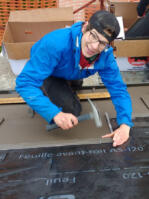Romania?
Unlike a Twilight Saga adventure, this trip wasn’t about tracking down vampires. It was about hunting for opportunities to help children who live in poverty. Sixteen students from Lyceum Alpinum Zuoz left home and travelled abroad to Romania, rich in history but one of the least urbanized countries in Europe, with the highest poverty rate. Their mission was to help support other young people who struggle with a life of poverty. As in years past, this teaching and travel experience was a joint project.
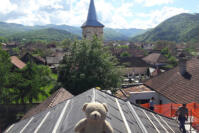
Corps of Volunteers – International Volunteering with Lyceum Alpinum Zuoz
At Lyceum Alpinum Zuoz, students enjoy a rich and rewarding life on campus, with state-of-the-art classrooms, a wealth of extra-curricular programs, high staff-to-student ratios, a global student body, and cozy accommodations. But every year, it’s gratifying that so many children choose to give back to the community by applying to join our Volunteer Corps projects for helping people in need. Students exchange their free time on vacation for nine days of travel in Europe with intensive physical work on projects. The experience of living and working abroad teaches them many things. On a social development level, interacting with other young people from different socio-economic backgrounds in another country can be an eye-opening experience. Travel and volunteer work abroad in Europe also builds students’ wider societal awareness, by showing them how their activities can have a positive impact on their community, their region, and even their world. It is one thing to learn about today’s social, cultural and economic inequalities in class, but it is quite another for children to travel and experience them first hand during real world programs. And using English as a shared language during project activities is great practical experience as well.
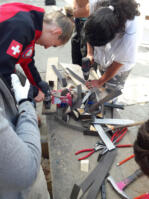
Learning for Life and Learning from Life
During their international volunteer activities, students not only gain a deeper insight into a foreign country and its culture, but they also deepen their geographic awareness and language skills. The experience offers them many opportunities to work hard, explore their own limits, and build much-needed infrastructure to improve the health and well-being of struggling communities. But the main lesson they learn is how to work together as a team. These practical lessons in conservation, and the values they teach, are becoming more and more important in today’s world, where mutual understanding, care and tolerance are sorely needed. The lessons that our students learn today will help them create the solutions we all need tomorrow. We hope that the experience will be a long lasting memory, which students treasure for the rest of their lives.
This year, student volunteers travelled to the countryside near Covasna, a city of 10,000 inhabitants in eastern Transylvania. This was the place which would host the team of volunteers as they worked to rebuild a local school, which badly needed a new roof and windows. As you might imagine, this international project required an extensive amount of planning.
According to geography teacher, Tiziana Gees, “In the months before the mission, we visited many potential sites, discussed multiple projects and how best to coordinate resources. Then from our search, we selected the ‘most feasible’ project and divided responsibilities, like, who would bring the scaffolding? How about the wood? The roofing materials? The municipality of Covasna in Transylvania provided free food and lodging and delivered wood for the construction site. The rest was provided by us. There was also a tinsmith and an architect who joined and advised us on our reconnaissance trips.”
After all the planning, the day finally arrived and the journey began.
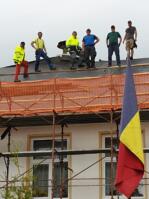
The Journey – Big Bears and Heavy Rain
The trip got underway on 6 May 2019 at 5:00am. Students and chaperones were picked up by a shuttle bus and driven to Bergamo, where they caught a plane to Romania, before finally arriving in Covasna by local minibus. Somewhere between Bucharest and Covasna, torrential rain began to pour, so the group took a break at a rest stop as to shelter from the rain. A road sign warned about bears in the area, so it would have been best not to go into the forest. However, this did not hold our students back. Everyone was amazed by how many animals – especially dogs – they spotted along the roadways. At about 8:00pm, the travellers arrived in Covasna, with stomachs growling louder than the bear at the rest stop. The entire project team drove to a local restaurant for dinner. The girls stayed in a ski house in Covasna and the boys stayed at a different accommodation, which was located in the forest to the south, near the Covasna campgrounds.
The next day, it was time for the team to meet the town. The mayor and the headmaster of the school, where the children would be working, welcomed the diligent helpers from Zuoz. And then the work began without delay, because there was a lot to get done and no time to waste.
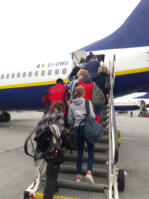
The Build – Many Hands Make Fast Work
Roofing a building requires a lot of safety, support, skill, and quite a bit of courage. The students helped to completely remove the old tiled roof, throwing the old tiles off the roof to remove the wooden slats, before installing a brand new PREFA roof system. After the old roof was removed, the students helped build a wooden formwork and applied insulation foil, to hold the PREFA plates and snow-stoppers. Then the volunteers removed all the old windows on the upper floor of the schoolhouse, and replaced them with new ones.
The Volunteer Corps was not alone. The team received safety support from Engadin-based construction workers, who had also come to Romania, to help guide the team through some of the more technical aspects of the build. Other helpers on site to support the volunteers included the school staff, and some Romanian students from the local community. There was a translator on site for helping the project along, and for teaching the Lyceum Alpinum Zuoz students their first words in Romanian and the Romanian students their first words in English. Teacher Imola Dragomer, part of the support team for the volunteers, helped to make the project happen, with organization and implementation assistance throughout the process.
Everyone on the volunteer team was very motivated and by working together, results came quickly. As a thank you for the visit, and all the help rebuilding the school, there was a big party on 11 May, with food, drinks and, of course, music. Local bands and dance groups were joined by school children, families, and community members, who all came together to sing and dance. There was some wonderful press and blog coverage of the event as well.
The journey was a success and plans for next year have already begun. If you need more information about the Corps of Volunteers or you’d like to join us and take part in the next project in 2020, please contact us and apply during the new school year. We will share more details, dates, and contact information during one of our first school assemblies.
